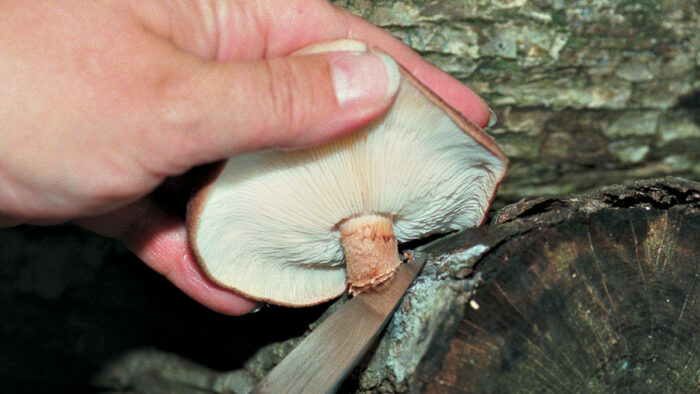
My husband turned me into a mushroom lover with the first course of the first meal he ever made for me. It was a hot and sour soup full of succulent shiitake mushrooms. I loved the firm texture of the shiitakes and the earthy, complex flavor they lent to the soup. But at $20 per pound and available only at specialty markets some distance from our home, shiitake mushrooms weren’t within easy reach.
With a little research, we discovered we could grow these delicious mushrooms ourselves. We found out that shiitakes (Lentinus edodes) raised at home are superior in taste, texture, and appearance to what is commercially available. To get there you must be willing to haul logs, drill and seed them, and keep them moist.
But 6 to 18 months after you stack your first shiitake logs, you could be harvesting mushrooms from your own garden. That’s exciting. But the really wonderful part of raising shiitakes is that the harvest continues for four to six years, sometimes longer.
Success with shiitakes begins with good logs. To produce 5 to 10 pounds of mushrooms a year for four to six years, you’ll need 12 to 15 logs, free of disease and damage, with bark intact. Our favorite shiitake log is a freshly cut 4-foot piece of white oak, 6 to 8 inches in diameter.
But shiitakes will grow on almost any hardwood: oak, chestnut, beech, alder, gum, or sugar maple. Poplar will work, but it decays quickly. Logs as small as 3 inches in diameter can be used, but they will deteriorate swiftly and dry out too easily, killing the mycelium, the unseen network of filaments that compose the vegetative part of the fungus that penetrates the wood.
We have used ridiculously large logs, but we don’t advise it. If you manage your logs carefully, you will be handling them a couple of times a year and you’ll be glad you kept them under 8 inches Logs may be cut from the time trees in your area have shed their leaves until a month before they begin to bud. It is best to inoculate the logs a week to a month after cutting because they need to be moist and full of nutrients for the fungus to take hold and spread well. Leaving the logs lying around for longer than that can cause them to dry out and allow weed fungus to invade the sapwood.
In colder climates, like Wisconsin and Canada, logs can be cut and left over winter without danger of invasion by weed fungus or drying, since the damp, cold weather doesn’t allow for the spread of disease spores.
Get started with spawn
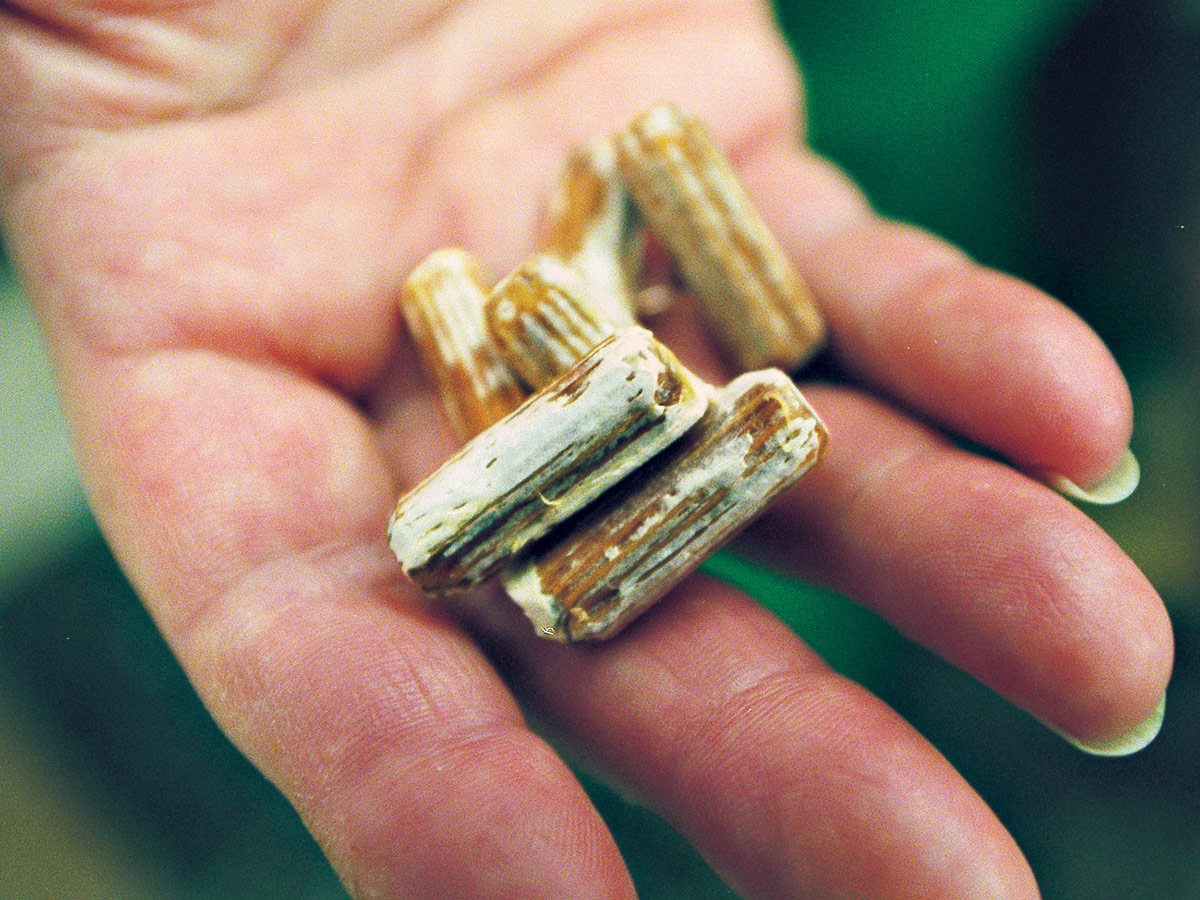
After you have obtained logs, it’s time to order mushroom spawn, or seed that gets the fungus going. The short dowels impregnated with spawn come in jars or plastic bags. Check them carefully to make sure they are covered with a pulpy white and tan material. They should not be dried out and brown. Your supplier will have recommendations for the best strain to be used for your area and level of experience.
Shiitake spawn is available in three strains: cold weather, warm weather, and wide range. The differences are in their fruiting habits and when they are most likely to bear. Wide range is usually recommended for beginners. Be sure to tell your supplier the dimensions of the logs and the number you will be using so you don’t run short of spawn when your project is under way. Keep the spawn refrigerated until a day or so before use. Expect to pay upwards of $35 for enough spawn for a dozen logs.
Spawn must be well sealed in logs
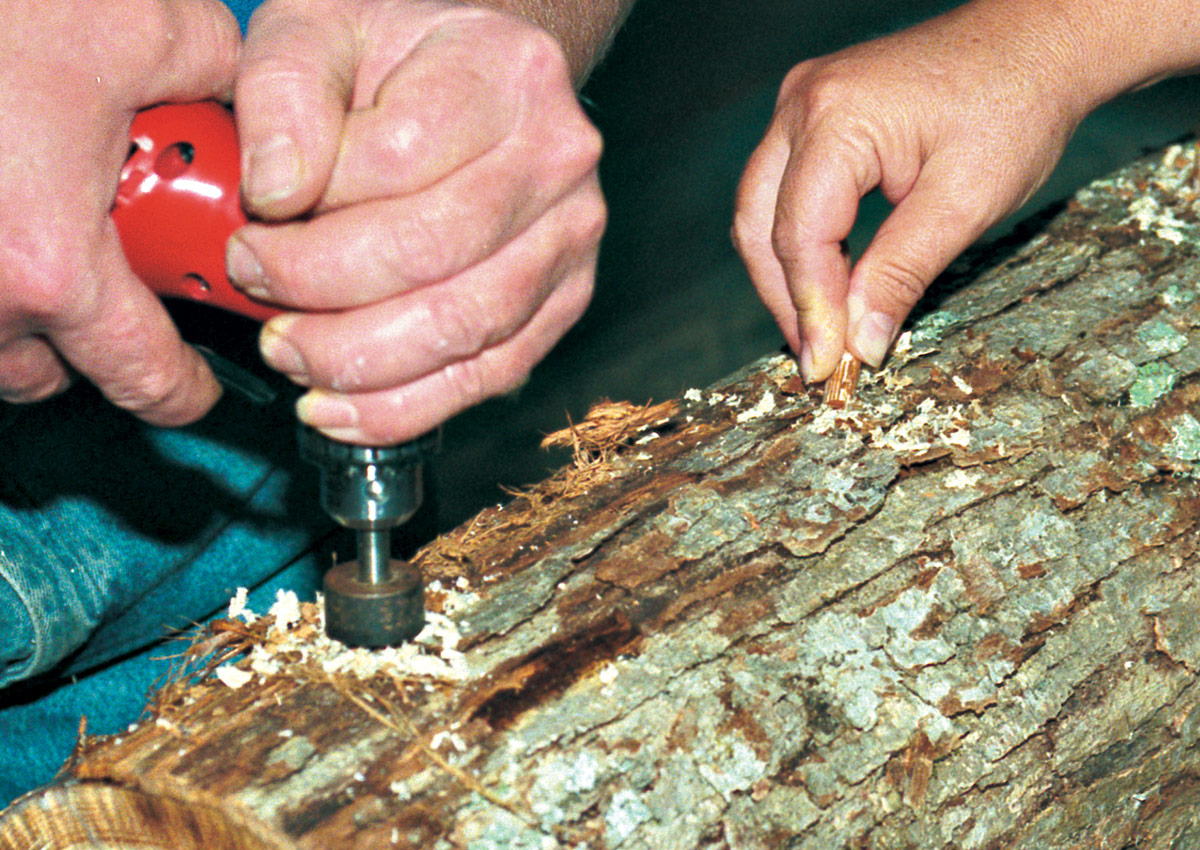
We use our art studio for inoculating the logs, since it has a concrete floor and provides protection from direct sunlight. A garage, carport, or workshop with sufficient workspace would be ideal. It’s handy if your work area is close to the site where you will be stacking the logs, since you’ll be carrying them the whole way. The process may also be done outside, so long as you are in the shade.
Little in the way of special tools is required. You’ll need a high-speed power drill, sawbucks to support the logs while they are inoculated, a hammer, a hot plate and container to melt the wax used to seal the spawn into the logs, and a brush to apply the wax.
Shiitake spawn spreads faster with the wood grain than across it
So we drill the holes closer together around the log than along its length, making an elongated diamond pattern. Drill holes that match the diameter and length of the spawn dowels. Insert the dowels into the holes and then give them a gentle tap with the hammer to push them down to or slightly below the log surface.
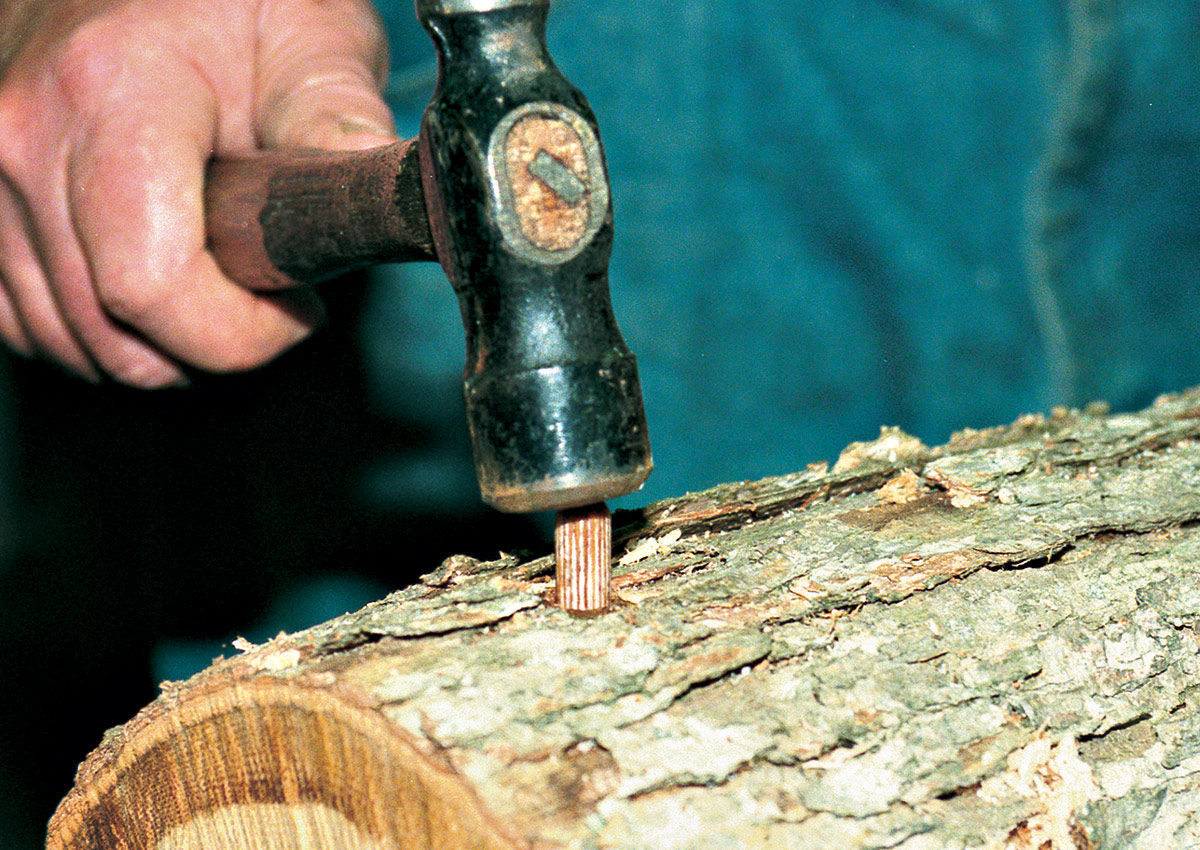
The dowels should not be allowed to protrude from the hole or they will dry out. Brush excess sawdust from the log with a brush reserved for this purpose and lightly apply melted wax with a brush to cover and seal the dowels. We use a 4 to 1 mix of common paraffin to petroleum jelly; this mixture creates a wax that is pliable yet durable. Keep it warm enough to stay liquid, but not overly hot, as it becomes too runny. Cheese wax, available from spawn suppliers, is also good. Whoever handles the dowels must avoid touching other materials to prevent contamination.
Having at least three people on your inoculation team is invaluable. Each person can be assigned to a specific task, which eliminates having to change tools and positions. A team of three can put up two stacks of logs in a day. One person drills the holes, another places and pounds the dowels, and a third removes the sawdust and covers the dowels with wax. It’s handy to have a couple of strong folks to move the logs.
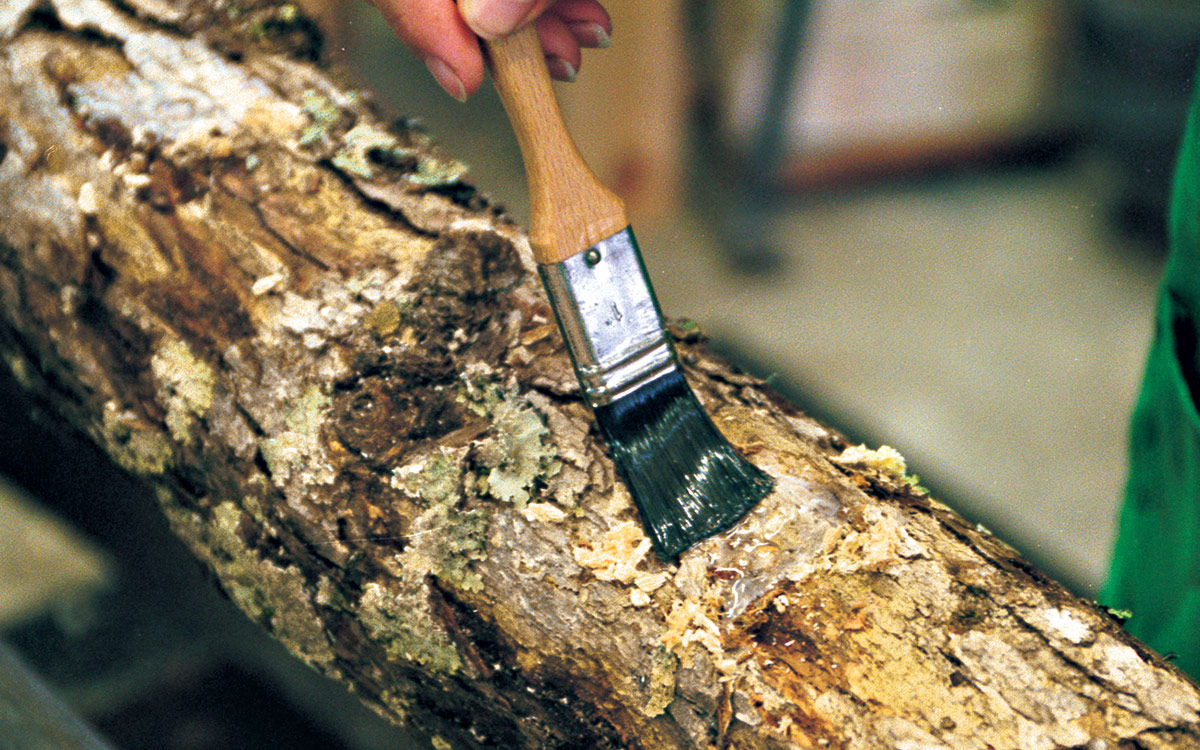
When choosing a site for your shiitake logs, consider close access to water for soaking or spraying the logs to keep them moist. If your stack is near the house, you will be more likely pay attention to what’s going on with the logs and you won’t miss mushrooms that pop up out of season. Handle inoculated logs carefully to avoid damaging the wax seals, and stack them in a well-ventilated area, with 60 to 85 percent shade. We configure ours like a log cabin.
Harvest shiitakes before they’re fully open
You can tell that the shiitake spawn has begun to colonize the logs when white funguslike growth rings appear on the ends of the logs. This happens 4 to 18 months after inoculation. Your first harvest will not be far behind. When the weather is right, small brown buttons will rise from the bark. This is called “pinning.” Mushrooms will follow in a few days if it stays warm and damp; cold temperatures and drying winds can stall them for weeks.
For the finest taste and texture, harvest shiitakes when the mushrooms are not fully opened. If you prefer larger mushrooms, let them grow until the cap expands completely, a day or two after the veil that protects the gills has separated from the stem. In either case, the mushrooms can be harvested easily by cutting the base of the stem with a sharp knife.
Moisture keeps shiitakes healthy
Some kitchen mushroom growers are laissez-faire, leaving the logs alone and letting nature take its course, just checking the logs for mushrooms during runs of damp weather. This unplanned fruiting is chancy; if shiitake logs are left to dry out when pinning, the crop will fail.
We manage our logs more closely by soaking them, because there’s a lot of drying wind in our area. Managing the mushrooms this way persuades them to fruit closer to your time preference. And we like to harvest a whole flush of mushrooms at once, for both immediate eating and for drying.
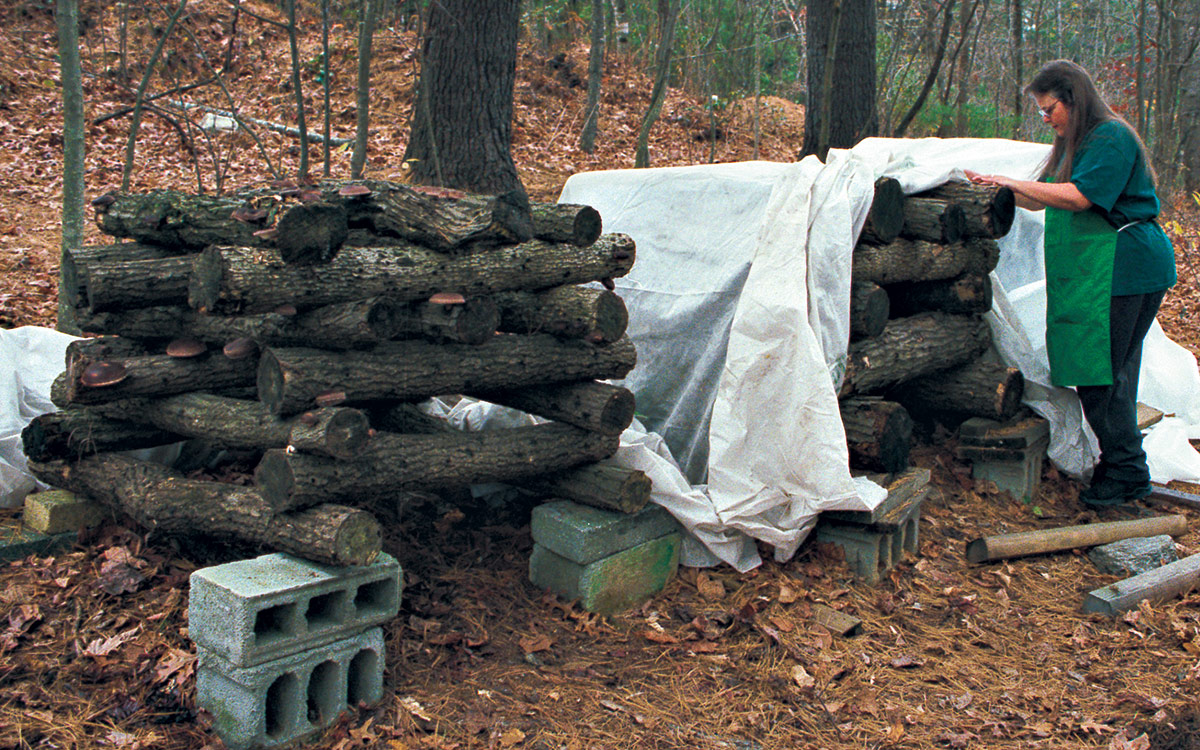
We have two large cast-iron bathtubs near the shiitake stacks in which we place six to twelve logs to soak overnight. Thoroughly soaking the logs during the growing season encourages pinning around the whole log. We do this twice a year, in the spring and fall, regardless of variety, because the pest-free mushrooms we harvest during these seasons have better flavor and texture. Summer mushrooms tend to have beetle and slug invasions.
You can help the logs stay moist after soaking by spreading clear plastic over the stack. If young mushrooms or logs become too dry, mist with a greenhouse mister.
If unstacking, soaking, and restacking sounds like too much work, you can try a variety that responds to sprinkling rather than soaking. For this method, set up a greenhouse mister on a board at the base of the shiitake stack and cover the logs with plastic for several hours while spraying the logs with gentle pressure.
Theoretically, the logs have a maximum harvest life of seven years. Harvest life depends on weather conditions, how heavily the logs produce, and the log diameter. Since we want a constant supply of mushrooms, we start a new stack every two or three years. This past spring, we harvested a couple of pounds of shiitakes from our very first stack of logs, which is 12 years old.
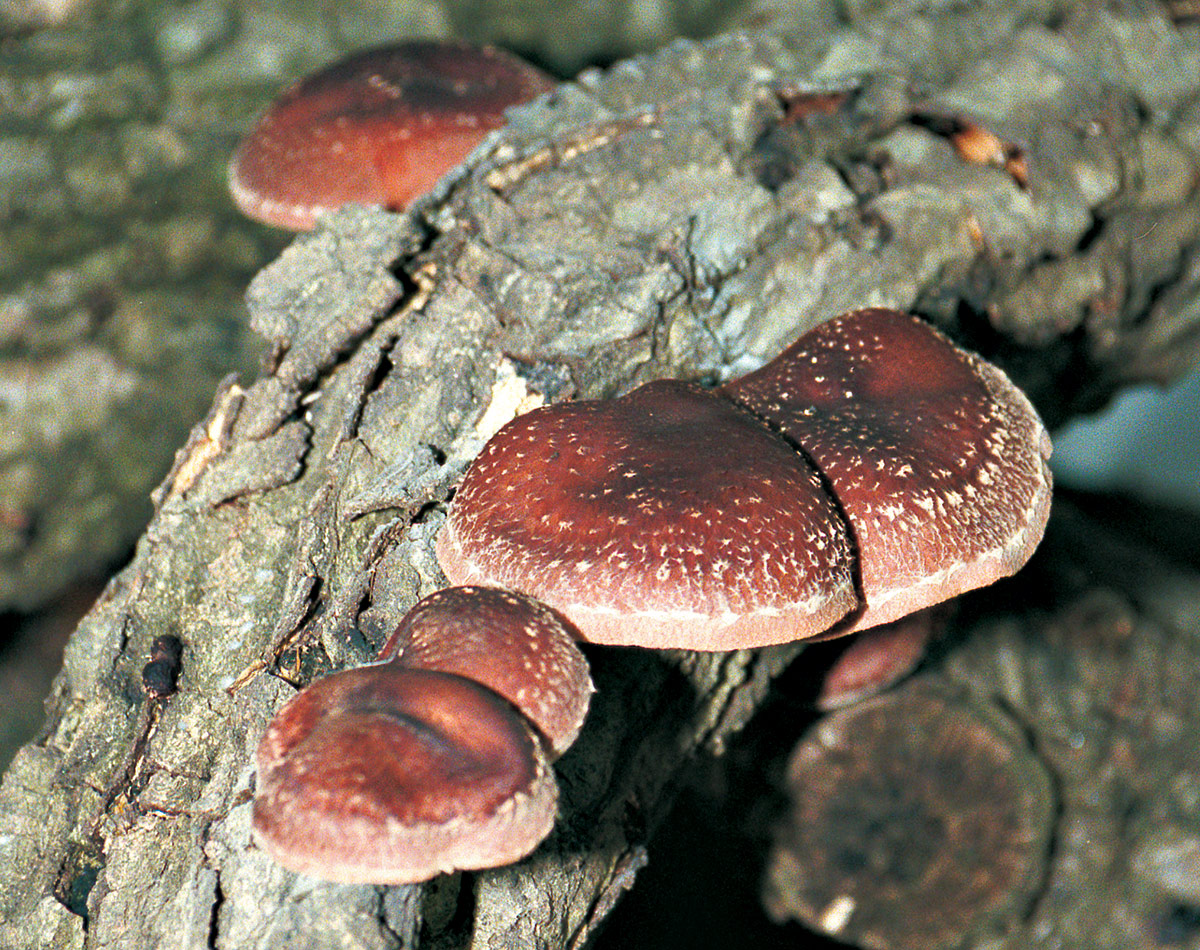
Pests and diseases haven’t bothered our shiitakes
What little weed fungus has occurred has never seriously impeded production. If the logs are strong and healthy and well colonized with shiitakes, problems of this nature are usually few. A handbook on raising shiitakes will give more detailed information on competitive and disease fungi. We recommend these two references: Shiitake Growers Handbook: The Art and Science of Mushroom Cultivation by Paul Przybylowicz and John Donoghue (Kendall/Hunt Publishing, 1998; 800/228-0810); and Growing Shiitake Mushrooms in a Continental Climate by Mary Ellen Kozak and Joe Krawczyk (Field and Forest Products, 1993; 15/582-4997).
Discourage deer from getting a taste of your mushrooms, though; they love them and can become real pests. Perhaps the deer are instinctively attracted to the shiitakes for their excellent nutritional value.
Shiitakes provide tasty nutrition
Few recurring crops besides raspberries have given us as much pleasure and yield as our hearty and flavorful shiitake mushrooms. Shiitakes are comparable to beans and peas in protein and are loaded with minerals and vitamins. hey’ve been used in Chinese medicine for thousands of years to promote health and maintain resistance to disease.
After harvest, they can be stored in a paper bag in the refrigerator, where they will keep for about two weeks. Another way to handle more shiitakes than you can consume fresh is to dry them. Drying intensifies and improves the flavor. Home dehydrators are perfect for drying shiitakes.
We have found that we can harvest all the shiitakes we want from our logs. And now, what seemed like a mysterious process at first has become a skill.
Sources for spawn, equipment, and information on growing shiitake mushrooms:
- Field & Forest Products, Inc., Peshtigo, WI, fieldforest.net
- Fungi Perfecti, Olympia, WA, fungi.com
Mary Lynn White lives in Spruce Pine, North Carolina, and has been growing mushrooms for 12 years.
Photos: John Bray
From Kitchen Gardener Issue #23

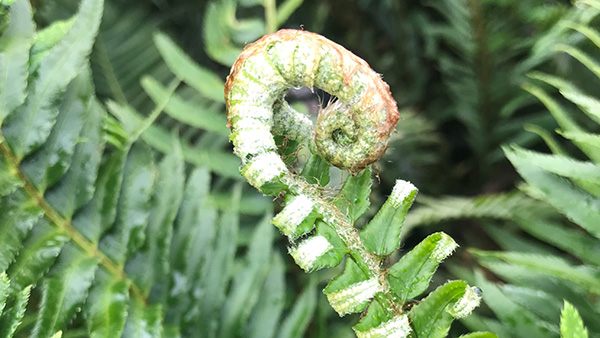

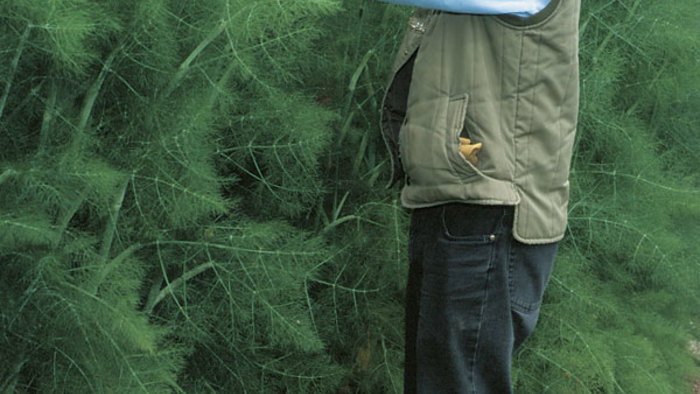













Comments
Log in or create an account to post a comment.
Sign up Log in